Some early hasty notes on the Liberal Party of Canada leadership race
Jul 8th, 2012 | By Randall White | Category: In Brief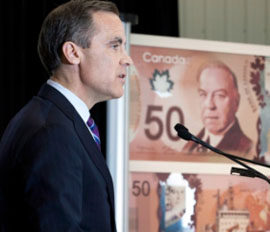
Bank of Canada Governor Mark Carney introduces a new $50 bill made of polymer that has the face of former (Liberal) prime minister William Lyon MacKenzie King and Canadian Coast guard ship Amundsen in Quebec City, Monday, March 26, 2012. Jacques Boissinot / THE CANADIAN PRESS.
[UPDATED JULY 10]. One progressive view of the Liberal Party of Canada leadership contest – which will have its final moment of truth sometime in April next year (or at least “in the first half of 2013”) –Â is that it no longer matters.
Consider, eg, these recent numbers: “Back on June 18 … we heard that ‘New Democrats Edge Slumping Conservatives … Across Canada, 35 per cent of decided voters and leaners … would support the NDP in the next federal election, while 34 per cent … would cast a ballot for the Tories … The Liberal Party is third with 19 per cent …’Â Then on June 30 it was reported that: ‘A weighted average of recent polls, on www.threehundredeight.com, puts the NDP ahead of the Conservatives 34.9 percent to 32.7 percent, with the Liberals well back at 20.9 percent.’”
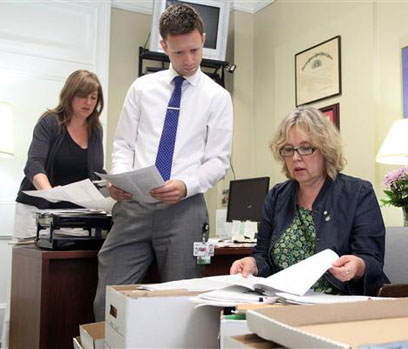
Green Party Leader and MP Elizabeth May in her office with staff members (L-R) Chief of Staff Debra Eindiguer and Legislative Assistant Paul Noble in the Confederation building in Ottawa, June 21, 2012. Photograph by: Kier Gilmour, Postmedia News.
Yet the appearance of a gladhanding Justin Trudeau at the Calgary Stampede this weekend, en famille (including the remarkable Sophie Gregoire), has raised questions about this scenario. For one thing it is almost certainly more than three years before the next Canadian federal election. And if a week is a long time in politics, who knows what could happen in three years?
Personally, I still believe it will take some kind of co-operation between M. Mulcair’s New Democrats and the Liberals to replace the Harper Conservatives with a more progressive government in Ottawa – more in tune with the real feelings of the majority of Canadians. I was attracted to Nathan Cullen’s campaign in the recent federal New Democrat contest. (See, eg: “More cheers for Nathan Cullen’s NDP leadership bid .. the new republic in Canada may be closer than we think?” and “Is Nathan Cullen the conscience of New Democrat race in Canada?”) And I continue to think he was and is onto something – towards which the former Quebec Liberal Thomas Mulcair is not altogether averse!
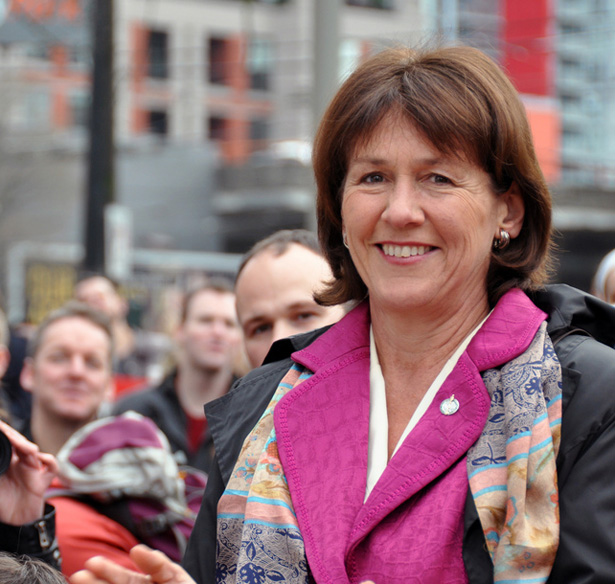
Joyce Murray, Liberal MP for Vancouver Quadra and former BC provincial cabinet minister, at Vancouver antiprorogation rally, January 2010.
So … Justin Trudeau at the Calgary Stampede has finally pushed me into getting my necessarily very early and hasty thoughts about the federal Liberal race into some kind of preliminary and of course very tentative order. To start with, under the guidance of two major sources (Susan Delacourt at the Toronto Star and the anonymous authors of the current Wikipedia site on “Liberal Party of Canada leadership election, 2013”), I have put together a list of 30 prospective candidates. I have then reduced this list to a personal Top 10 – and finally further reduced the Top 10 to what at least seems to me at the moment my personal Big Four.
You could of course say that any political party for which journalists and other pundits are talking about as many as 30 prospective leadership candidates is far from dead in the water yet. (Or, if you were especially perverse or partisan, you could of course say the opposite : too many cooks etc.) In any case, if you want to see the entire list of 30 you should click on “Read the rest of this page” and/or scroll down. In this more privileged space I will just quickly list the Top 10, and then more quickly (and a bit more below briefly comment on) the subsequent Big Four.
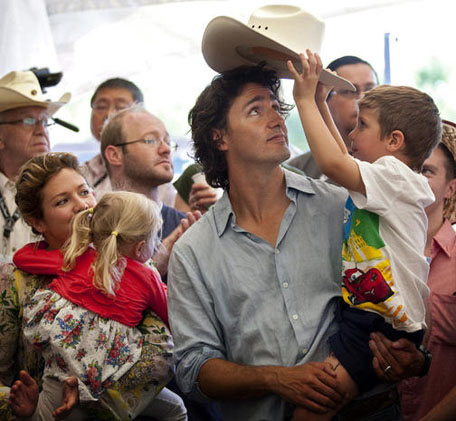
Liberal MP Justin Trudeau, centre, has his cowboy hat taken by his son Xavier, 4 years-old, while his wife Sophie Gregoire, holds daugher Ella-Grace, 3 at the Calgary Stampede, July 7, 2012. JEFF MCINTOSH/THE CANADIAN PRESS.
The Top 10, in alphabetical order (and certainly just as far as I am concerned, which may or may not be a plausible barometer of something larger at this stage) are: Mark Carney, Deborah Coyne, Marc Garneau, Ralph Goodale, Mark Holland, Gerard Kennedy, Dominic LeBlanc, Elizabeth May, Joyce Murray, and Justin Trudeau.
My Big Four on this list, for the moment at least (and again in alphabetical order) are: Mark Carney, Elizabeth May, Joyce Murray, and Justin Trudeau. [CLICK ON “Read the rest of this page” and/or scroll down for JULY 10 UPDATE on David Merner and Justin Trudeau.]
* * * *
I certainly agree that there is absolutely nothing to suggest current Bank of Canada Governor Mark Carney is at all interested in the leadership of the Liberal Party of Canada. He does, however, say rather classically Canadian liberal things from time to time.
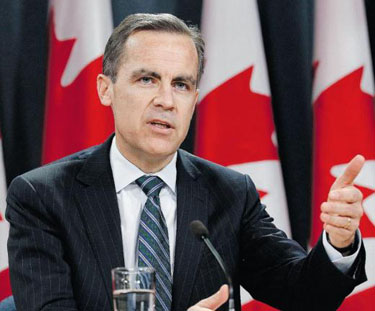 Mr. Carney’s origins in both Western and Northern Canada – along with the plain fact that he was appointed to his present position by Mr. Harper – also make him, in my own jaded opinion, the ideal candidate for Liberal leader at this point in the history of the true north strong and free. (Even if not at all enough Canadian people – most of whom do not regularly follow the goings-on at the Bank of Canada – know enough about him yet to give him strong polling numbers!)
Mr. Carney’s origins in both Western and Northern Canada – along with the plain fact that he was appointed to his present position by Mr. Harper – also make him, in my own jaded opinion, the ideal candidate for Liberal leader at this point in the history of the true north strong and free. (Even if not at all enough Canadian people – most of whom do not regularly follow the goings-on at the Bank of Canada – know enough about him yet to give him strong polling numbers!)
Elizabeth May, of course, is at the moment the Green Party leader. Yet, as one of her prominent environmentalist supporters has recently pointed out: “She will put people and progress before partisan politics, and we need more of that.”
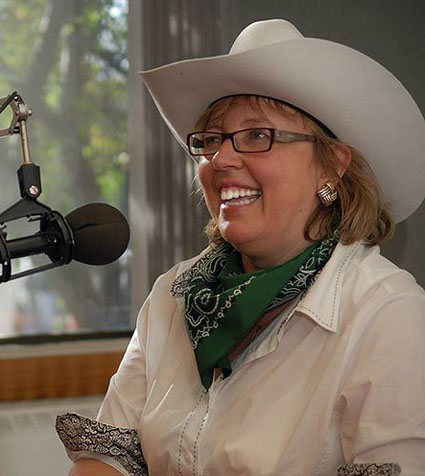 It helps as well that Ms. May currently represents a BC riding in the federal Parliament. As is often but probably not often enough noted, far too many current Liberal leadership prospects come from Ontario and Quebec – or points still further East – at a time when the Canadian West is rising. Similar considerations lie behind my nod to Joyce Murray – MP for Vancouver Quadra and a former BC provincial cabinet minister. (Oh and btw, I want to have equal numbers of women and men in my Big Four list, if only to keep the women in my own life onside.)
It helps as well that Ms. May currently represents a BC riding in the federal Parliament. As is often but probably not often enough noted, far too many current Liberal leadership prospects come from Ontario and Quebec – or points still further East – at a time when the Canadian West is rising. Similar considerations lie behind my nod to Joyce Murray – MP for Vancouver Quadra and a former BC provincial cabinet minister. (Oh and btw, I want to have equal numbers of women and men in my Big Four list, if only to keep the women in my own life onside.)
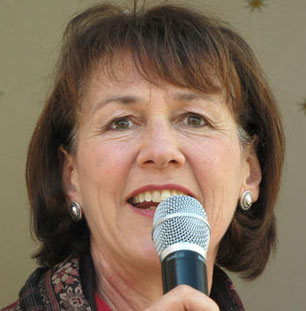 Finally, Justin Trudeau, MP for the Papineau riding in Montreal, in many ways breaks the rule about getting away from Ontario and Quebec. At the same time, it is often said that he is first and foremost the son of his mother from BC, and he has developed his own intimate connections with Canada’s Pacific coast. (Among other things, eg, he has a Bachelor of Education degree from the University of British Columbia, and worked for a time as a social studies and French teacher at Sir Winston Churchill Secondary School in Vancouver.)
Finally, Justin Trudeau, MP for the Papineau riding in Montreal, in many ways breaks the rule about getting away from Ontario and Quebec. At the same time, it is often said that he is first and foremost the son of his mother from BC, and he has developed his own intimate connections with Canada’s Pacific coast. (Among other things, eg, he has a Bachelor of Education degree from the University of British Columbia, and worked for a time as a social studies and French teacher at Sir Winston Churchill Secondary School in Vancouver.)
Say whatever else you like, Justin Trudeau does have very strong polling numbers at the moment – among Canadian Liberals and (more importantly) among the Canadian electorate at large. He will apparently not be telling us whether he will actually run for the Liberal leadership until late this summer or even early this fall. But assuming Mark Carney does remain just a pointless pipe dream of people like me, if Justin Trudeau (and his remarkable wife) do decide to reach for the top, I would agree he will be the front runner. All things considered, he could be just what the ancient doctors of Canadian Liberalism ordered for the fateful year of 2013 as well – and even more for the next federal election in 2015. I am myself more enthusiastic than I thought I might be at one point about Thomas Mulcair’s new New Democrats. But I also don’t think the Liberal Party of Canada has reached the end of its historic manifest destiny yet.
* * * *
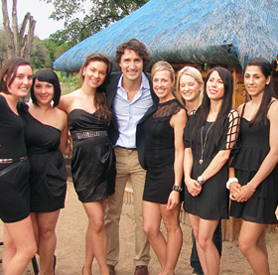 For those who are really interested in the subject already, even in the summer heat that has engulfed so much of our magnificent Canadian northern geography – from Bona Vista to Vancouver Island – here is my original list of 30 prospective candidates. As already noted, it draws on two major sources : Susan Delacourt at the Toronto Star and the anonymous authors of the current Wikipedia site on “Liberal Party of Canada leadership election, 2013.”
For those who are really interested in the subject already, even in the summer heat that has engulfed so much of our magnificent Canadian northern geography – from Bona Vista to Vancouver Island – here is my original list of 30 prospective candidates. As already noted, it draws on two major sources : Susan Delacourt at the Toronto Star and the anonymous authors of the current Wikipedia site on “Liberal Party of Canada leadership election, 2013.”
I should preface the list itself with a few extra details. First, Martha Hall-Findlay appears on both the Delacourt and Wikipedia lists, but I have left her off my list because she still has not paid off her debts from the 2006 Liberal leadership campaign – which suggests she just won’t be able to raise the money for 2012-2013. Second, Marc Garneau currently does rather well in some opinion polls, but he has not made my ultimate Big Four list because I think his current strong polling just flows from his name recognition as a former astronaut – which I do not believe will last myself. (Of course I could be quite wrong!) Finally, among the 30 prospective candidates listed below only three have actually declared their candidacy as of today, July 8, 2012 – Deborah Coyne, Shane Geschiere, and Jonathan Mousley. So, all this having now been said, here is the list, again strictly in alphabetical order:
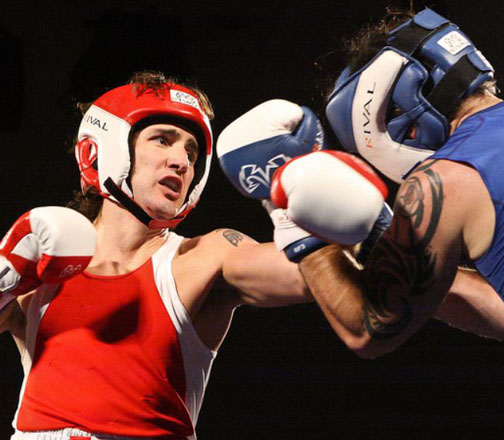
Who knows? Justin Trudeau’s surprise knockout of Conservative Senator Patrick Brazeau earlier this year may foretell how he would surprisingly lead the Liberals against the Conservatives in the 2015 election?
David Bertschi
Scott Brison
Mark Carney
Martin Cauchon
Jean Chrétien
Denis Coderre
Deborah Coyne
Marc Garneau
Shane Geschiere
Ralph Goodale
Jean-Marc Fournier
Mark Holland
Gerard Kennedy
Dominic LeBlanc
John Manley
Paul Martin
Elizabeth May
David McGuinty
Frank McKenna
David Merner
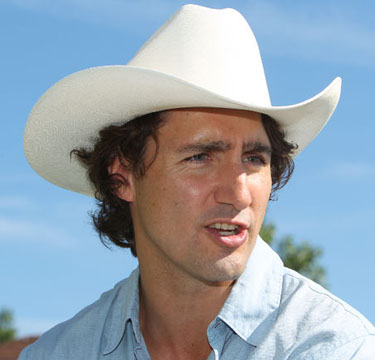 Jonathan Mousley
Jonathan Mousley
Joyce Murray
Naheed Nenshi
Taleeb Noormohamed
Geoff Regan
Belinda Stronach
George Takach
Brian Tobin
Justin Trudeau
Borys Wrzesnewskyj
UPDATE JULY 10: Along with the interesting comments on the Clarity Act from Harry Perlman below, two further pieces of intelligence since I rushed this hasty report together this past weekend have prompted me to rush together a hasty update:
(1) DAVID MERNER ON LIBERAL-NDP CO-OPERATION : In yesterday’s Globe and Mail Gloria Galloway reported: “The possibility of co-operation – and perhaps even a merger – with the New Democrats as a means to defeat Conservatives in the next federal election is promising to become a key battle line in the looming Liberal leadership race, whether the Liberals like it or not … At least one potential contender is already saying he would campaign for co-operation. David Merner, a Liberal for more than 30 years who recently quit as president of the British Columbia wing of the party to test the leadership waters, says the issue would be at the heart of his campaign … Mr. Merner, an admitted dark-horse candidate, said he supports the ideas floated by New Democrat MP Nathan Cullen during the NDP leadership race that federalist parties on the centre and left should nominate candidates jointly at the riding level. ‘We are no longer the governing party,’ Mr. Merner said. ‘And we’ve got to look at how we co-operate.’”
As noted above, “I was attracted to Nathan Cullen’s campaign in the recent federal New Democrat contest.” And (not that anyone important really cares, of course) this fresh intelligence about David Merner in the Liberal campaign just might make me change my Big Four list above to a Favourite Five list : Mark Carney, Elizabeth May, David Merner, Joyce Murray, and Justin Trudeau. I note as well that Calgary Grit has reported David Merner “does meet three of the requirements on the official ‘Liberal leadership BINGO card’ – he was born in Alberta, used to play hockey, and is fluently bilingual.” Finally, there is some additional data on Merner in another recent (July 5) list of prospective federal Liberal leadership candidates from Sonya Bell, Colin Horgan and Jessie Willms at iPolitics.
(2) A CAKEWALK FOR JUSTIN TRUDEAU ALREADY? In yesterday’s Toronto Star the always interesting Chantal Hébert meditated on the already near front runner status enjoyed by Pierre Trudeau’s eldest son: “Even without a decision, Justin Trudeau emerging as Liberal leadership frontrunner … Notwithstanding their elected status, Trudeau’s fellow MPs cannot hope to contend against him on anything approaching a level playing field … At almost 140,000 subscribers, Trudeau’s Twitter following alone is larger than the post-leadership membership of the federal NDP … Not all of them are fans, of course, but Trudeau’s base remains many times larger than that of any other prospective contender. That translates into a formidable fundraising edge; one that is reinforced by favourable polling data … It is not necessary to subscribe to the narrative of a near-miraculous Liberal recovery under Trudeau to find that none of the other would-be candidates generates a fraction of the popular interest that he attracts … For many attention-deprived Liberals, he offers an irresistible combination of leadership assets.”
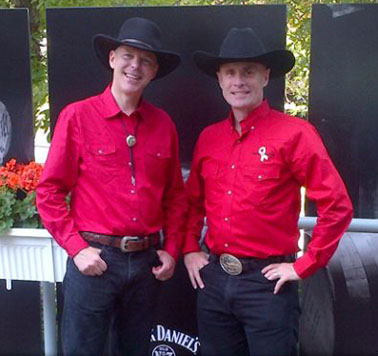
At the 100 th birthday of the Calgary Stampede, with Alberta Liberal Party president Todd Van Vliet (right) and his old family friend David Merner, former BC Liberal Party president, and a prospective candidate in the federal Liberal Parrty leadership race.
The only qualification to this I can think of at the moment myself is that it is still a long while between now and next spring. And it will even be a while yet before Justin Trudeau tells us whether he is actually going to run or not. At the same time again, I can also remember the counterweights editors’ meditation from early this past March : “The quiet evolution of ‘La femme de Justin Trudeau’ carries on .. almost as if it knows what it’s doing?” I also wonder myself just how much influence Ms. Gregoire-Trudeau will be having on the final decision. I of course don’t know anything at all about her, but just from her media profile she sometimes seems more ambitious than her husband – and very much ready to play a strong role in his political career. But perhaps that is quite wrong?
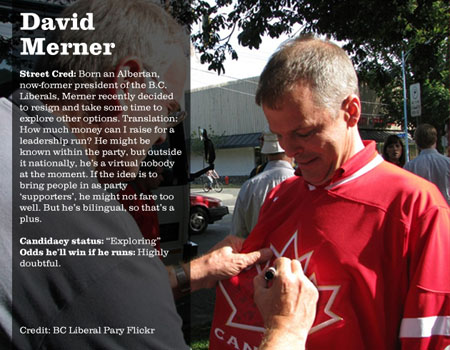


“I am myself more enthusiastic than I thought I might be at one point about Thomas Mulcair’s new New Democrats.”
For a website calling itself “Counterweights” this surprises me. The NDP’s Sherbrooke Declaration is anti-counterweights. How do reconcile that, or do you not care?
I’ve discussed your question Harry with my fellow bloggers here. And I don’t see how the “NDP’s Sherbrooke Declaration is anti-counterweights†— unless you think that “counterweights†is just a synonym for slavishly following all the particular views of the late great Pierre Trudeau. Everyone here, on the other hand, seems to agree that Trudeau’s general political theory of “create counterweights†leaves open the possibility that such things might be necessary against some of his own particular views, that time has shown to be wanting.
If you are really interested, I have discussed my views on Pierre Trudeau’s legacy in “Whether you loved or loathed him, no one is as big as Pierre Trudeau in Canadian politics today.â€
http://www.counterweights.ca/2010/09/whether-you-loved-or-loathed-him-no-one-is-as-big-as-pierre-trudeau-in-canadian-politics-today/
As I noted there: “Pierre Trudeau was not only more interesting than other Canadian politicians, of his or any other generation, he was also more interested in Canada and the Canadian future … He actually had a coherent historically-rooted vision of the modern country, that transcended its transitional 19th century status as the first self-governing dominion of the (now fallen, and inevitably obsolete) British empire. It was a flawed vision. But at least it was a vision.†More exactly, “as the Ontario historian Robert Bothwell quipped years ago, the Montreal-native Pierre Trudeau’s flawed vision of Canada stretched ‘from one end of Montreal Island to the other.’â€
The Sherbrooke Declaration actually goes on for several pages. And, as I read it, it is at least trying to come to terms with Trudeau’s flawed vision. It declares that : “Fully understood and recognized, Quebec nationalism can be a strength for Canada, not a threat.†And it was one of the ingredients that went into the November 2006 Canadian House of Commons resolution that “ the Québécois are a nation within a united Canada†— which was supported by every Liberal MP from Quebec, and most from the rest of Canada too. No doubt, the Sherbrooke Declaration has its own flaws, as a former speechwriter for Michael Ignatieff was urging on Macleans’.ca last month. But it is at least trying to grapple with 21st century Canadian unity issues that even a Liberal Party of Canada led by Pierre Trudeau’s eldest son will have to confront in fresh ways, if it is going to move the country forward (or even just get some fresh traction for the party itself in Pierre Trudeau’s old stronghold of Quebec). Cheers, RW.
http://www.scribd.com/doc/56396467/NDP-Sherbrooke-Declaration
The Clarity Act is a counterweight to the type of trickery separatists have employed in past referendums. The Sherbrooke Declaration rejects the Clarity Act.
From The NDP’s separatist pandering threatens national unity by Stephane Dion:
Just like the Bloc, the NDP argues that a majority of 50%-plus-one is the only valid rule in a democracy. Yet even the NDP requires a two-thirds majority to amend its own constitution.
Just like the Bloc, the NDP argues that in a referendum based on a question selected by a secessionist government, a majority of a single vote would be enough to trigger Quebec’s secession, however unclear the question or uncertain the majority. This runs directly against the 1998 decision of the Supreme Court of Canada in the secession reference, and The Clarity Act, which the NDP once supported.
Just like the Bloc, the NDP argues that accepting such a lack of clarity is a mark of openness toward Quebeckers. Sorry, but considering it acceptable to expose us Quebeckers to a confused and confusing attempt at secession is anything but a mark of openness toward us. On the contrary, defending our rights means guaranteeing that we will never lose Canada unless we clearly want to. We were guaranteed this “right to Canada†by the Supreme Court. Demagogic politicians cannot take that right away from us. Ed Broadbent understood that very well.
Against all logic, the NDP argues that its position is in keeping with the Supreme Court opinion. The only NDP MP to denounce that argument as absurd is Roméo Saganash, who represents the Quebec riding of Abitibi-Baie-James-Nunavik-Eeyou. If the Court thought that “50% plus one†would be good enough to trigger secession negotiations, why did it mention the words “clear majority†at least 13 times in its opinion? Why did it also refer to “the strength of a majorityâ€? If 50%-plus-one is a clear majority, what constitutes an unclear majority?”
http://fullcomment.nationalpost.com/2012/03/12/stephane-dion-ndps-separatist-pandering-threatens-national-unity/
Who said anything about Pierre Trudeau’s vision of Canada?
I appreciate your more detailed description of your concerns here Harry — and the reference to the piece by Stephane Dion, who has already shown how little he understands Canada today in the 2008 election (although I confess I did vote Liberal then myself, and I think M. Dion remains an admirable person in many respects). But it does at least seem to me that this finally is an argument about Pierre Trudeau’s flawed vision of Canada — and perhaps even the Liberal Party’s continued unwillingness to face up to the real problems with this flawed vision.
I think you (and Stephane Dion) are placing far too much stress on the one comparatively brief part of the Sherbrooke Declaration (in section 6), which asserts that the NDP “would recognize a majority decision (50% + 1) of the Quebec people in the event of a referendum on the political status of Quebec.â€
I think it is equally worth noting that section 6 also says: “It would be to the Federal government to determine its own process in the spirit of the Supreme Court ruling and under international law, in response to the results of the popular consultation in Quebec.†It seems to me that there is considerable room here for Ottawa — to say nothing of the other nine provincial governments — to deal effectively with what you call “the type of trickery separatists have employed in past referendums†Harry, in the event of another future referendum in Quebec, on a “sovereigntist†question devised by a PQ government.
It seems to me as well that, if there ever actually is another such referendum, and the PQ wins by “a majority decision (50% + 1)â€, the Clarity Act is not really going to protect people in Quebec like you, or people in Ontario like me, or people in any of the other eight provinces and three territories, from the time of great trouble and deep uncertainty about the Canadian future that would ensue. The Clarity Act has always struck me as quite a lot like the Maginot Line in France after the First World War. It may have made some French people feel safer for a time, but when push finally came to shove it just didn’t work.
Like you perhaps Harry, I have been watching the great debate about Quebec separatism for a long while now. (I am in my late 60s and have lived in Ontario virtually all my life.) What I feel very clear about at this stage is just this: If a seriously separate and independent Quebec ever were to somehow come into being, that would be the end of Canada period. There would be no discussion about future relations between Canada and Quebec and so forth, because there would finally be no Canada. And the deepest political truth about our confederation is that neither Canada nor Quebec can exist without the other — in one way or another. I have some if not infinite confidence that after two referendums and much else since the first PQ government was elected in 1976, the majority of the Quebec people (and perhaps even something very close to the francophone majority) have begun to appreciate and accept this … sort of, maybe, and so forth.
What is needed now, I think, is some fresh and serious discussion or debate or discourse or whatever you want to call it about just what the November 2006 Canadian House of Commons resolution that “the Québécois are a nation within a united Canada†means in practice. It sometimes does seem to me that Mr. Mulcair’s new New Democratic Party is at least trying to get a little closer to all this than the current federal Liberals. Gotcha games about the Clarity Act just don’t do the trick for me. I do think the Sherbrooke Declaration has its own flaws. And if I had written it myself I might even have tried to leave out the “(50% + 1)†clarification in section 6 — and just more vaguely said “a majority decision.†But I do still like the last paragraph of section 6 better than I like the Clarity Act: “For the NDP it is necessary to propose a positive vision of the future rather than contribute to polarize the debate. We want to develop a new attitude towards the whole debate, as our work must contribute to the reinforcement and renewal of federalism, not to maintain entrenched positions.†Again, however, I do appreciate and respect your concerns Harry, even if I don’t agree with them in the end myself. That’s my idea of what “counterweights†means. And I’m still not sure whether, when push finally does come to shove in 2015, I’m going to vote Liberal or NDP?